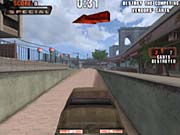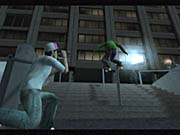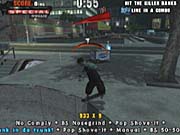When it comes to Tony Hawk's Pro Skater, there are some standards that have remained constant throughout the entire series. In the game's career mode, you picked a professional skater and went from level to level, completing goals that really didn't have much to do with being a professional skater. Year after year, the career mode got bigger and bigger, piling on more and more goals and slowly tying them into the pro skater's real-life career. Sure, starting with the second game in the series, you could create your own skater, but that was more of a secondary bonus than anything else, and the focus from year to year was on a series of new moves that kept the gameplay fresh and made the next installment in the series just as addictive as the last. This year, rather than focus on replacing the levels and adding new layers of depth to the gameplay, Activision and Neversoft have tried to turn the entire series upside down, taking the focus off of the skaters who are already professionals and instead putting the spotlight on an unknown skater and his quest for fame, which takes him from the mean streets of New Jersey to the heights of skateboarding stardom. While the classic Tony Hawk gameplay is present, and still fantastic after all this time, the new story mode doesn't make as dramatic of a change as it probably could have.

So the career mode from the Pro Skater games has been morphed into a story mode in Underground. Since the story relies on you being an unknown, it requires you to use a created skater. The first order of business, when starting the game, is to create a skater, though you can go back and change your skater's look at any time. The options for your skater are pretty good, with a lot of different parts to resize and texture, and accessories to place, like shorts, shirts, hats, glasses, and so on. The PlayStation 2 version of the game takes the personalization one step further by letting you map a photo of your face onto your skater. Once you've created a skater, the game puts you on the streets of New Jersey as just some skater kid without a lot of money to his name. Chad Muska comes to town to skate a demo, and one of your goals is to impress Chad. He recommends that you get sponsored by your local shop, and your quest for fame and glory sets off from there. As you proceed, you'll get into wacky hijinks and travel the world, but you'll mostly learn to hate your "good buddy" Eric, who tags along for the ride, annoying voice work and all.
The story mode is where we encounter Tony Hawk's Underground's first real problem. The game has been redesigned to be all about you, as this customizable skater rising to fame. It's been redesigned to tell a story, but the story it tells isn't written particularly well. It has its ups and downs, but most of the game's goals don't tie into the story at all, and the game doesn't really make effective use of the long list of professional skaters in the game, which has expanded to include Arto Saari and Paul Rodriguez. Mike Vallely, who appeared in Tony Hawk 4 as a hidden skater, now appears on the regular roster as well. The pro skaters pop up rarely in the story, so in most cases they're merely found skating around in levels, offering extra special trick slots if you can complete their challenges.

In between each of the game's 27 chapters, you'll advance the story a bit, but the story doesn't have very many interesting twists and turns, and it doesn't end in a particularly satisfying fashion, either. While the concept of following a skater from the bottom to the top is a great idea, the dialogue here could have been better, and the game's objectives should have been integrated a little tighter with that story. As it stands, the game essentially has you attempting to accomplish the typical sorts of goals that the Pro Skater series is known for--like collecting a lot of items and doing a lot of specific tricks. You'll collect scraps of sheet meter, Hawaiian leis, doughnuts, stickers, and lots of other little trinkets along the way. You'll also have to perform specific tricks in certain situations, reach specific score plateaus, and achieve other typical Tony Hawk-style goals. As you become a sponsored amateur and, eventually, a bona fide pro skater, you'll partake in judged competitions. These are two-out-of-three timed runs, and they work roughly identically to the competition levels that have been in the series since the beginning.
There are also goals that don't really require much skating. For example, you'll be asked to drive a car on numerous occasions, and you'll even hop off your board and do some light, Tomb Raider-styler platforming by climbing up onto buildings, shimmying power lines, and so on. While hopping off the board has value as a combo expanding gameplay element, the driving in the game is ill-conceived. The cars look and control pretty poorly, and the goals involving vehicles seem like filler, much like some of the minigames--like hitting baseballs with your skateboard--found in Tony Hawk 4.
For the first time in the Tony Hawk universe, the new game has difficulty settings. Four, to be exact, and each setting does different things to the game's goals. Time and score limits are the most obvious changes, as the easy setting practically takes away most of the game's goal timers, while the "difficult" setting forces you to act fast. There's even a supereasy setting that simplifies the game's physics a bit in an attempt to make it extrasimple for new players to get into the game. On the game's normal setting, an experienced Tony Hawk player should be able to bust through the entire story in well under 10 hours. The hardest difficulty setting does make the game a little rougher, so anyone who has played the heck out of Tony Hawk 4 should simply start right at the top to ensure a decent challenge. Different things are unlocked at the end depending on which difficulty you're playing.

Each installment in the Tony Hawk's Pro Skater series has added new gameplay elements that expand the system's overall potential by allowing you to use more and more tricks and items in combos. Tony Hawk's Underground picks up where the Pro Skater series left off by adding the aforementioned ability to get off of your board. This is mostly used for a few on-foot goals, but you can also use it in combos. Hopping off your board midcombo causes a small meter to appear and slowly drain. This is your run meter, and you need to get back on your board and back into a traditional combo before it expires to keep your combo going. This is a cool addition because it allows you to hop off and completely change direction, which is helpful. You can also execute wall plants and wall pushes, which also add new ways to use the game's terrain for combos.
Aside from these additions, the game plays roughly the same as Tony Hawk 4. The spine transfer, manual, and revert have all made it over intact, and the combo structure for moving from one grind, lip trick, or manual to another of the same type works just as it did in Tony Hawk 4. Some new tricks have also been added, though most of these are wackier-looking specials. The gameplay additions are pretty cool, and even though the changes might not be as revolutionary as the manual or revert were in their respective days, they freshen up the game, and it continues to have great open-ended, combo-based gameplay. Skater stats are handled differently in Underground. Instead of giving you points as you complete goals, the game has little extra challenges in the stats menu. Completing these challenges--like grinding for 20 seconds or executing three cavemans in one combo--will add a point to the appropriate statistic. This makes improving your skater feel more natural, though it also has the side effect of removing one of the key rewards you'd get for completing goals in the previous games.
The level design is quite different in Tony Hawk's Underground. Not only are the levels bigger, but they're also designed in a slightly more realistic fashion. The basic philosophy appears to be that each level has a series of really great skate spots, but they don't tend to overlap. Parts of the level that aren't filled with ramps, bowls, and other such items tend to be very grind-friendly, and the rails seem like they were designed to carry you from one skate spot to the next. The urban environments also contain a lot of hidden spots to skate on. Many rooftops will contain bowls, and you can even go inside some of the buildings to find even more skate-worthy material.

To go with the increased focus on create-a-skater, the game also lets you create plenty of other things. The level creator has been expanded in size and scope, giving you far more control over the design and complexity of your levels. You can even create goals and custom goal text for your levels. The game also lets you create your own tricks. Though you're limited to existing animations, you can tweak them quite a bit, adding flips, rolls, and the ability to use different trick animations together to create new-looking tricks. The tricks are scored automatically based on their complexity. Additionally, you eventually earn the ability to create your own skateboard by slapping on a few layers of existing graphics. The PlayStation 2 version's online support comes with the ability to upload and download this custom content, giving you the ability to try out other players' levels and goals.
Obviously, creating a skater is the most important custom feature, especially on the PlayStation 2 version, thanks to its support for custom face textures. The process to put your face on one of the game's skaters is a simple one. You must take a clean, straight-on, shadowless photo of your face. Then you send that shot in via e-mail or by using a cell phone camera. Shortly after sending in the shot, you'll receive an e-mail reply with an eight-character code. You then take that code to the game and enter it. The game then gets online and downloads the shot. From there, you need to line up the face's points to match those of the polygonal model, and you should ensure that the skin tone of the face texture matches the rest of the body. Then you can adjust the face's shape and size to get a more realistic look. Though this feature is a gimmicky one, it's very cool and actually does its job of making the game a little more personal.
Overall, Tony Hawk's Underground is a great-looking game. The levels are large and colorful, and the trick animation is as good as it's ever been. The game runs at a high speed, and, depending on which version you're playing, the frame rate is either completely smooth or mostly smooth. That said, it does have its rough spots. The skater models look fantastic from a distance, but up close they really don't look so hot. This is the same problem the series has had for the past two years, really, as the people you encounter for goals still look a little weird. Only now, you're seeing most of these models--or slightly enhanced versions of them--in the story mode cutscenes, so you get to see a whole lot more of them.

Most of the same gameplay sounds from previous entries in the Pro Skater series return in Underground, but since they perfectly fit the action, that's not much of a complaint. The game also has new sound effects, mostly for grinding different types of surfaces. You'll hear the trucks of your board clinking off of rails differently, and grinding power lines causes an electrical zapping sound. The game has a lot more speech than previous Tony Hawk games, and most of it is done pretty well. Your friend Eric gets a little annoying over time, but that's about it. Even the pro skaters do a decent job with their few lines.
The soundtrack in Underground is large and broken up by genre. This allows you to turn off specific genres of music if you're so inclined. You can also enable or disable any specific track. While the quality of the music is something best left up to your own likes and dislikes, the game covers a lot of ground, and includes acts like KISS, Deltron 3030, Murs, RA the Rugged Man, Bracket, NOFX, The Clash, and Sublime. More than 70 songs are included in all.
When it comes to comparing the three versions of the game, the Xbox may look the best, but the PlayStation 2 version wins due to its inclusion of online play and face mapping. The PlayStation 2 also takes the lead in the control department, as the timing-based moves of the Tony Hawk series simply work better on the PlayStation 2 controller, though the Xbox version isn't far behind. The stock GameCube controller's small D pad makes it a bit tougher to use than the other two, but the game remains playable on all three consoles. Graphically, the Xbox version is the best, as it contains the smoothest textures and frame rate. The PlayStation 2 version looks great for a PS2 game, but the frame rate tends to get a little jumpy here and there, and you'll see some slight tearing when you turn quickly in heavily populated environments. The GameCube version may have a slightly cleaner look than the PS2 version, but the frame rate is even more random here, which sort of gets in the way of the gameplay. On the sound side, the Xbox version sounds a little crisper than the other two, and it also has custom soundtrack support.
No Tony Hawk game would be complete without unlockable items, and Underground fulfills its hidden-item obligation by offering at least three hidden skaters and four unlockable levels, three of which are from a previous version of the game. While in the past, the hidden skaters have felt like a cool bonus tribute, one of the hidden skaters, the new hidden level, and the video that plays when you unlock that level feels more like a marketing tie-in for a recently released concert DVD than like a cool extra. Given the game's increased use of product placement--you're given the ability to put logos for several nonskateboarding company sponsors on your clothes, and a few goals take place directly in front of prominently placed logos for a fast-food chain--this isn't really all that surprising. That said, fans of the band that provides a good chunk of the unlockable content probably won't mind one bit, though it certainly isn't as universally interesting for its time as, say, Darth Maul was from Tony Hawk 3.

Like the last two Tony Hawk games, Underground has support for online games on the PlayStation 2. The modes found in Tony Hawk 4 all return here, including score competitions, best combo battles, graffiti, goal attack, and more. The new mode is called fireball, and it attempts to turn your eight-player matches into a deathmatch of sorts by giving you the ability to fire projectiles at the other players. You're given a health meter, and the last player standing wins. The online option in Underground has been expanded, a bit, extending the profile option found in Tony Hawk 4 to include stat tracking. The game also tracks high scores for all of the game's levels, which is a good way to see how you stack up against other players. Overall, the online support in the PS2 version is a nice, fun addition that brings a lot of replay value to the game. All versions of the game also have a two-player split-screen mode, and the Xbox version of the game has support for LAN play via system link.
In some ways, Tony Hawk's Underground is a bit of a disappointment. The way the game attempts to focus on the story, yet can't deliver a particularly interesting story, really holds the game back, and the game doesn't feel as different from the previous Tony Hawk games as it could. Even with that problem, fans of the series will certainly find a lot to like here, and the different difficulty levels make the game more accessible to a wider range of players. Most importantly, the core gameplay is still extremely entertaining, and some of the new additions, like being able to get off your board and execute wall plants, do make for some interesting, new possibilities. PlayStation 2 owners will get an extra kick out of the cool face-mapping feature and online play as well. All things considered, Tony Hawk's Underground is another great installment in the franchise.